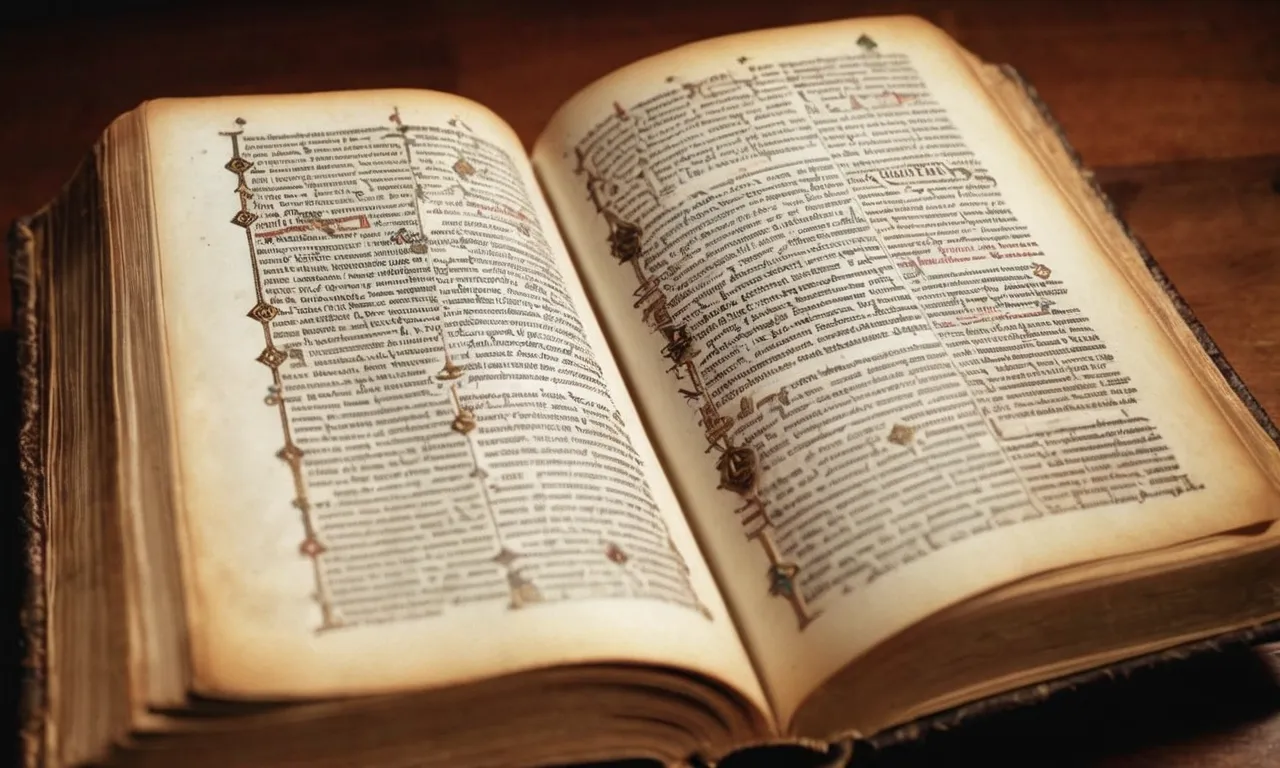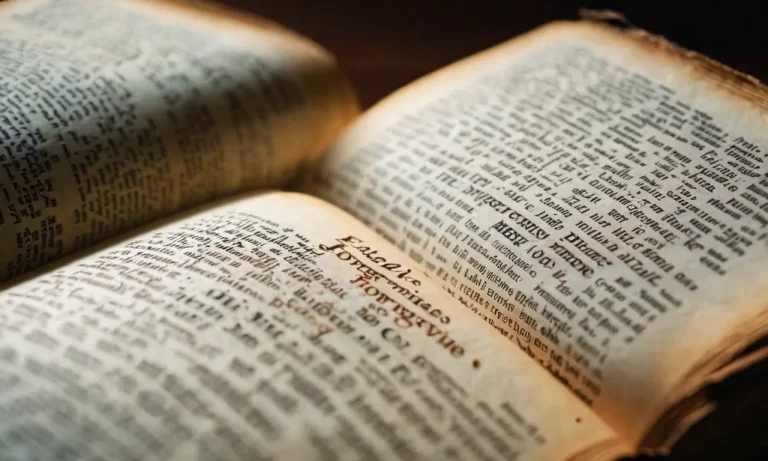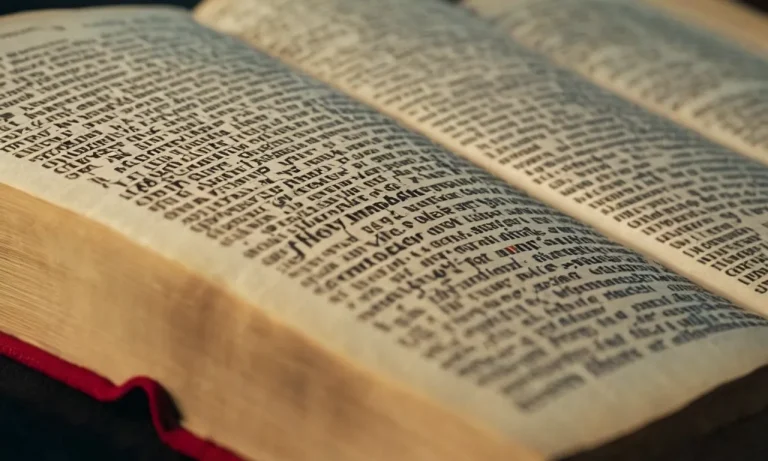Who Decided What Books Are In The Bible?
The question of who decided which books made it into the Bible is an intriguing one. For centuries, the compilation of books that make up the Bible has served as the sacred text for Judaism and Christianity.
If you’re short on time, here’s a quick answer: In the 4th century AD, church councils and synods convened to review many Christian writings and decided which texts were considered inspired by God to be included in the Biblical canon.
In this comprehensive guide, we will examine the key people, events, councils, and processes that led to the Biblical canon used by most Protestant Christians today.
The Old Testament Canon
The Torah and the Origins of the Hebrew Bible
The Old Testament canon began with the Torah, which consists of the first five books of the Bible – Genesis, Exodus, Leviticus, Numbers, and Deuteronomy. These books were likely compiled and edited between the 10th and 6th centuries BCE from earlier oral and written traditions passed down from Moses and other Israelite leaders.
The Torah established the Law and Covenant between God and Israel, and laid the foundation for the rest of the Old Testament canon.
According to tradition, Moses wrote the Torah under divine inspiration, though most scholars believe there were multiple authors and editors involved. The books contain a mix of narrative, law, poetry and ritual to tell the story of creation, the early history of Israel, the Exodus from Egypt, and the giving of the Law at Mount Sinai.
This core narrative became the lens through which later Old Testament writings interpreted Israelite history.
The Council of Jamnia and the Jewish Canon
The rest of the Old Testament developed over several centuries, reaching its near final form by the 2nd century BCE. After the destruction of the second Jerusalem Temple in 70 CE, Rabbinic Judaism leaders likely held the Council of Jamnia to discuss which books should be included in the Jewish canon.
They debated books like Ecclesiastes and Song of Solomon before confirming a canon largely matching today’s 39 books of the Protestant Old Testament. By closing the canon, they distinguished scripture from the rising literature of rabbinic scholarship.
The Council of Jamnia represented a key step in solidifying the Old Testament accepted by Judaism. Their discussions continued the process of canonization that had been ongoing in Judaism for centuries.
Extrabiblical Books of the Septuagint
The Septuagint (LXX) is a Koine Greek translation of the Hebrew scriptures produced in Ptolemaic Egypt during the 3rd and 2nd centuries BCE. In addition to the canonical books, it contains extra writings such as Tobit, Judith, Wisdom, Sirach, Baruch and Maccabees.
These books and additions to canonical books are referred to as the Apocrypha or deuterocanonical books.
Though widely used by Greek-speaking Jews and later Christians, these books were not included in the Hebrew canon. The early rabbinic canon found at Qumran suggests Jews had closed their canon before the inception of the LXX.
Jerome in the Latin Vulgate marked the extra LXX books as apocryphal or non-canonical. Most modern Protestant Bible translations followed suit, but Catholic and Eastern Orthodox Bibles largely still include the Apocrypha, though their canonicity is sometimes disputed.
Development of the New Testament
Paul’s Letters and the Gospels
The earliest Christian writings were the letters of the apostle Paul, written in the 50s and 60s A.D. These letters were circulated and read in early Christian communities before the Gospels were written down.
The first Gospel written was the Gospel of Mark around 70 A.D., followed by Matthew and Luke in the 80s A.D. These biblical texts emerged naturally as the early Christians sought to share the story of Jesus and continue the teachings of their leader who had been crucified just a few decades before.
The Muratorian Fragment and Early Canons
In the late 2nd century A.D., a document listing some of the books considered canonical by Christians at the time called the Muratorian fragment provided early evidence of a New Testament canon coming together.
This and other early canons included the four canonical gospels and many of Paul’s letters, establishing the central place of these texts. But beyond this core, there was still dissensus, and Hebrews, James, 2 Peter, 3 John, Jude and Revelation remained disputed in some church circles into the 4th century A.D.
Eusebius and the Road to Standardization
It was not until Bishop Eusebius of Caesarea wrote his Ecclesiastical History in 324 A.D. that a New Testament list very close to today’s emerged. Seven disputed books still known as the Antilegomena, including James and Revelation, continued to be debated in some Eastern churches.
But in 367 AD the bishop Athanasius of Alexandria included them in his annual Easter letter, giving the 27 books of our New Testament today ecumenical authority. Although hooked shaped check marks and question marks continued to appear in margin notes over controversial books for centuries, what Christians broadly accept now as canonical had largely coalesced.
Key Church Councils and Synods
The Council of Nicaea and Aftermath
In 325 CE, the First Council of Nicaea was convened by Emperor Constantine to address the Arian controversy that challenged the divinity of Christ. Led by Athanasius, the council affirmed the full divinity of the Son as being of the same substance as the Father, settling an important Christological debate of the early church.
The council also established when to celebrate Easter. Despite initial opposition, the Nicene Creed that came out of the council eventually gained wide acceptance, becoming foundational for orthodox Christian doctrine.
Athanasius Defines the New Testament
In 367 CE, Athanasius, Bishop of Alexandria and staunch defender of Nicene orthodoxy, wrote an Easter letter that contained the first known list of the 27 books of the New Testament canon. His list, which was likely ratified by the Synod of Alexandria that same year, reflected what had already become the consensus of the church regarding the canon.
This recognition of the New Testament canon by an authoritative figure in the church was a crucial step towards establishing the biblical canon as we know it today.
Councils of Hippo and Carthage
In 393 and 397 CE, the regional Councils of Hippo and Carthage in North Africa affirmed the canonical list of 27 New Testament books that had been articulated earlier by Athanasius. Under the leadership of Augustine, the councils also recognized the full canon of the Old Testament.
The actions of these councils reflected what had become the widespread consensus of the church and effectively closed the New Testament canon for the next millennium. The Catholic Church recognizes Hippo and Carthage as the councils that definitively articulated the complete biblical canon of 46 Old Testament and 27 New Testament books that Protestants embrace today.
The Protestant Reformation and Biblical Canon
Erasmus and the Textus Receptus
The Protestant Reformation in the 16th century led to questions about which books should be included in the Bible. Desiderius Erasmus, a Catholic priest and renowned scholar, produced the first published Greek New Testament in 1516.
This landmark work was called Novum Instrumentum omne and later became known as the Textus Receptus. Erasmus compared and compiled the most reliable Greek manuscripts he could find to produce a revised Greek text that differed substantially from the Vulgate, the Latin Bible used by the Roman Catholic Church at that time.
Martin Luther Questions the Apocrypha
Martin Luther relied on Erasmus’ Greek New Testament to produce a German translation of the Bible in 1522. Luther questioned the canonicity of the Apocrypha, books included in the Septuagint and Latin Vulgate but not in the Hebrew Bible.
He separated these books into a section between the Old and New Testaments and wrote prefaces expressing doubts about their apostolic origin. Luther’s German Bible was hugely influential and led others to publish full vernacular Bibles for common people to read.
The Westminster Confession of Faith
In 1643 the Westminster Assembly of English Puritans and Scottish Presbyterians produced the Westminster Confession of Faith, a landmark Reformed confession. Chapter 1 lists the 66 books of the Protestant canon, 39 in the Old Testament and 27 in the New.
This established the canon used today by most Protestants. The Roman Catholic Church reacted at the Council of Trent in 1546 by affirming its canon, including the Apocrypha. This difference remains between Protestant and Catholic Bibles to this day.
Ongoing Debates over Canonicity
Differences Between Christians and Jews
Christians and Jews have slightly different versions of the Old Testament in their Bibles. The Jewish Tanakh contains 24 books divided into three sections: the Torah (Law), the Nevi’im (Prophets), and the Ketuvim (Writings).
However, the Protestant Old Testament contains 39 books, including some books that Jews consider non-canonical or apocryphal. For example, while Jews recognize the Torah as authoritatively binding, apocryphal books like Tobit or 1 Maccabees are not considered canonical or divinely inspired by Jewish scholars (Encyclopaedia Britannica, 2023).
The Apocryphal Books Controversy
There has also been debate among Christians over the apocryphal books found in Bibles. Apocryphal books refer to texts that did not make it into the Jewish Tanakh or the Protestant Bible canon for various reasons.
For instance, most Protestant Christians rejected the apocryphal books during the Reformation in the 1500s while Catholics accepted them at the Council of Trent. To this day, Catholic and Orthodox Christian Bibles contain 7 more books in the Old Testament than Protestant Christian Bibles (GotQuestions.org, 2023).
Those who argue against the apocryphal books point out historical concerns, such as the fact that apocryphal works were never part of the Jewish canon, questioned authorship, and disputed dating. Supporters argue that early church leaders like Augustine viewed them as Scripture and that they have spiritual and historical value.
Ultimately, it comes down to differences in authority and tradition.
Modern Christians and the Biblical Canon
Today, most Christians accept the 27 books of the New Testament and 39 books of the Old Testament (66 books total) as carrying divine authority and comprising the closed biblical canon. However, there are occasional discussions over whether later writings could potentially join the canon.
For example, some Christians have pointed to influential works like The Pilgrim’s Progress or The Imitation of Christ as contenders. But so far, no further writings have gained widespread acceptance into the core canon that early church councils formalized long ago.
A 2021 survey by Ligonier Ministries and LifeWay Research found that 75% of U.S. evangelical Christians say no other books meet the standard to be recognized as Scripture (LifeWay Research, 2021). So despite some ongoing debates, most Christians consider the biblical canon to be closed regarding authoritative Scripture inspired by God.
Certain secondary writings may still be valued but not on the level of the Bible’s 66 canonical books.
Conclusion
While many faithful Christians and Jews believe scripture was divinely inspired, we have seen the very human process that brought the Biblical canon into existence. Through intense debate, political pressures, and thousands of years of use within religious communities, the collection of books known as the Bible emerged gradually.
The question of ‘who decided’ continues to this day, as different denominations use slightly different Biblical canons. Yet most faithful believe that while men did the compiling, the books themselves reflect divine truth and spiritual authority.








